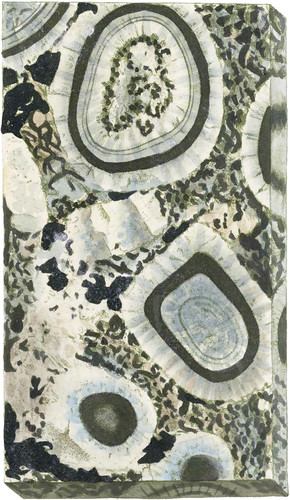 Enlarge
Enlarge
Exotic Mineralogy
- Syn. Roche Quartzeuse avec Actinote, Granit globuleux de Corse. Haüy 4. 431. Mathieu, Annales du Museum d’Histoire Naturelle. 14. 82. English Extract of Do. Phil. Mag. 35. 222.
The small plain of Talavo, near Stranzona, in the island of Corsica, afforded a solitary block of this curious and singular variety of Sienite. It was first discribed by Sionville and Barral in the year 1785, since which time several blocks have been found by Mr. Mathieu of the French artillery, on the estate of Sarteni. It is chiefly semitransparent Quartz, some of which, by diverging from a centre, is formed into roundish nodules, including agranular dark green substance, much resembling Chlorite, sometimes rather confused, and in greatest abundance towards the centre, yet often forming thicker or thinner alternate coatings with the Quartz in a very neat manner. These nodules are imbedded in or surrounded by an aggregate of Quartz, the granular green substance, and almost black crystals of Hornblende. The Quartz in some parts is more or less transparent, and sometimes grayish, greenish, or stained with ochre. The annexed figure has the usual appearance, and the cutting and polishing gives the sections of the globes, and makes them distinct, admirably pretty, and better understood. “In Mathieu’s memoir the blocks are described as loose, lying on the side of a very steep mountain, extended over a space of about 400 square metres, with the appearance of having been detached and rounded by the action of the weather. Their being found on an elevated and inclined situation, indicates that they could not be far removed from their original situation, but it is to be regretted that the discovery was not prosecuted a little farther, and the nearest solid rock examined. By this memoir it seems evident that this curious stone occurs in Granite, but what connection it has with the real Granitie of the country, we have yet to learn. Possibly it may occur in a vein; it may form part of a bed; it may be a part of an included mass.—But we can yet only conjecture as to its particular relations.”
“It may be here remarked, that Granite, according to the Wernerian doctrine, cannot contain one particle of Amphibole (Hornblende,) consequently this stone, in which it abounds, cannot be considered as a Granite; besides, from my specimens, it does not appear that the enumeration of the component parts is correct, either in Mathieu’s memoir, or in any other publication. Haüy says, it is composed of whitish Quartz and dark green actinolite (actinolite and Hornblende, according to him, are synonymous). Brochant says. Feldspar (in the text Quartz, which is corrected in the errata) and Hornblende. This appears clearly composed of Quartz, Hornblende, Foliated Chlorite, and a few minute crystals of Feldspar, constituting what may be considered Sienite.”
T. A.

